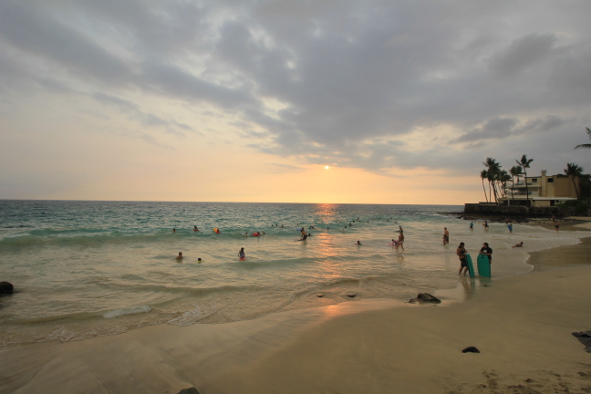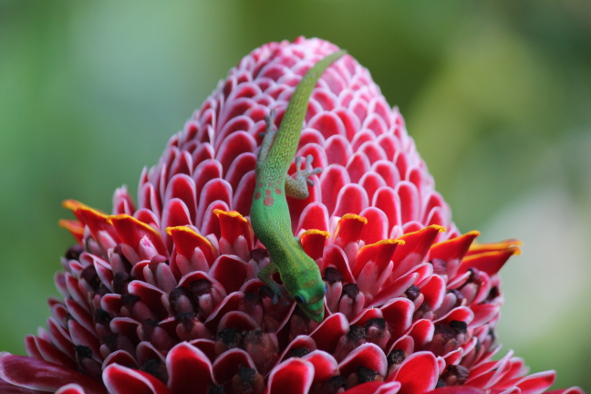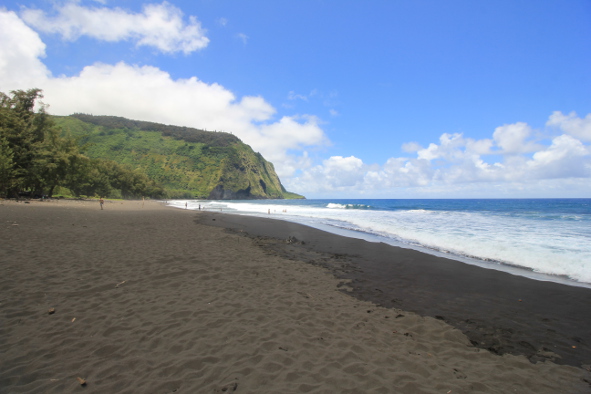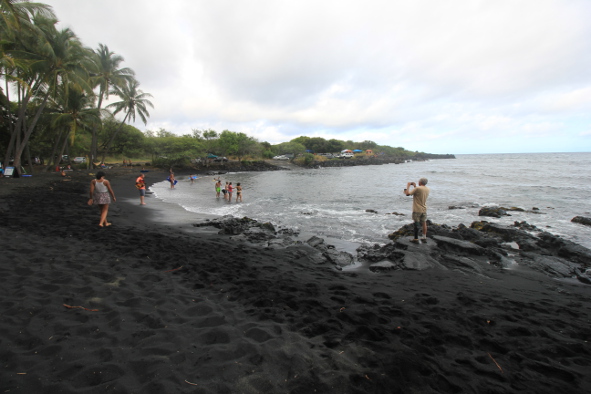The Island of Hawaii encompasses 10 of the world’s 14 climate zones in just 4,028 square miles, most of which are devoid of human contact. The result is a dizzying variety of wildlife that gives visitors plenty of incentive to explore both rainforests and deserts of volcanic rock looking for local residents, whether they be plant or animal, on land, under sea, native or non-native.

Magic Sands Beach (Photo: Jeff Rindskopf)
A vibrant green gecko creeps along the whitewashed wall of my rented room in Kailua-Kona on the Island of Hawaii (aka Big Island). “Aren’t they supposed to be good luck?” I ask my host. She laughs and shakes her head. “They’re everywhere.”
Within walking distance of my room, I glimpse more than just geckos. Scuttling crabs and hard-shelled limpets hold tight to jagged rocks in wave-slammed tide pools, invasive yet adorable mongooses root through private gardens, and a great big Black Witch Moth settles on the ceiling above my bed for the night. This is all in touristy Kailua village, the most densely populated part of Hawaii’s Big Island.
The wildlife elsewhere on the island is even more overwhelming and fascinating. It is a world away from anything you can see in continental USA, with new species of plants and animals waiting to be discovered in every corner of the island.
Swimming the Kona Coast
Black rocks and white sand are always battling for prominence on Hawaii’s picturesque beaches. The rocks at Baby Pond Beach near my room keep out the waves and create a calm lagoon of clear blue water, prime territory for first-time snorkelers such as myself.
Beneath the surface, I spot scores of colorful fish like Yellow Tangs and Moorish Idols crisscrossing near sea urchins embedded in underwater rock. The fish occasionally seem to congregate into little meetings, only to disperse in a thousand different directions when I swim through them.
Once I’ve explored other nearby beaches and stepped on one of those painful but only mildly-poisonous sea urchins, it’s time to venture further out into the endless Pacific and swim with the dolphins. The pods of bottlenose dolphins are easy to find close to shore, and they’re not shy about showing off.

A pod of bottlenose dolphins near Kailua-Kona (Photo: Jeff Rindskopf)
They surround the small boats that abound in the Kona harbor and leap entirely out of the water, twirling in the air for a moment like aquatic ballerinas before submerging themselves once more. I hop in alongside them and do my best to keep up, often coming within inches of touching their sleek polished skin. Once I’ve finished, my captain has cut into one of the island’s white pineapples, an impossibly sweet, non-acidic summer treat that alleviates the taste of all the salt-water I can’t help swallowing on occasion.
I venture out aboard the same boat once more in the evening, just as one of Hawaii’s world-famous sunsets paints the clouds in fiery orange hues. This time, I’m swimming with the manta rays, buoyed by a surfboard fitted with lights that illuminate the underwater landscape and attract plankton, which in turn attract the rays.
It works like a charm. The gray-winged creatures swoop suddenly out of the darkness every now and again before disappearing. They must be at least 18 feet long. Some do nimble backflips, coming so close to the surface I have to raise my legs to keep from touching their pearly white underbellies, opening their enormous mouths before swimming gracefully onward.
The Rainforests
There are few better ways to see the natural diversity of the Big Island than by driving across it, watching the entire landscape seamlessly blend into something new several times over. Driving from Kona to Hawaii’s other modest metropolitan area Hilo, I spot goats, cattle and Nene – Hawaii’s state bird and the rarest goose in the world – as volcanic beaches turn to arid grassland and then to black dirt desert and finally to dense rainforest.
While Kona is like a collection of businesses made to serve tourists in between snorkel trips, Hilo feels more like a real town: a little gritty and weathered from the sea air but colorful and inviting nonetheless. Pop-up fruit stands dot the roadside now and again, selling guava, passionfruit, poha berries, mango, and coconut water drank straight from the coconut.
Despite the trappings of civilization, the vegetation is unstoppable on this half of the island. I’m particularly amazed by the banyans: trees that start life growing on other plants but eventually become vast systems of interconnected branches gathered into thick trunks and spread out over large areas, with their broad glossy green leaves blotting out the sky above.

A Gold Dust Day Gecko near Akaka Falls (Photo: Jeff Rindskopf)
I drive north on Highway 19 and the rainforests become even more dramatic, with layers upon layers of trees and other plants looming high above, so impenetrable and thick with plant life I can’t imagine how they ever cleared enough space to create a road through it all. I make a short hike to the gorgeous drop-off of Akaka Falls through the most oppressive humidity I’ve ever experienced. A few geckos scurry along the edges of the path, looking much more vibrant in this environment than they did on the walls of my hotel room.
My day trip to the east side of the island ends at Waipio Valley, the first in a chain of gorgeous valleys where waterfalls cascade down to gently curved beaches hemmed in by cliffs covered with more of that unstoppable vegetation. The hike to the beach is short but almost impossibly steep, blocked in one place by a wild horse frozen in place with fear, one rear hoof poised and ready to kick anyone who comes too close or moves too suddenly. Several more wait and watch in the trees as I snap photos and creep by as cautiously as I can.

Waipio Valley (Photo: Jeff Rindskopf)
For my final guided tour of the trip, I drive to the rainforest town of Hawi, which receives about a hundred extra inches of rain per year compared to the arid, resort-heavy Kohala coast just a few miles to the south. The area was once home to dozens of sugarcane plantations, which relied upon a complex irrigation system simply called “the ditch,” constructed by underpaid and overworked Japanese laborers in 1905.
Sugarcane disappeared from the region as labor became cheaper elsewhere, with the last plantation closing in 1996, but the manmade flumes remained, carving out a remote path through rainforests otherwise untouched by civilization. The tour is something like an amusement park log ride but with authentic, untouched surroundings, offering another way to see some of the Big Island’s remarkable plant life.
When he isn’t telling irresistibly corny jokes, our guide gives some context for the abundance of edible vegetation that’s been around me the entire trip. Invasive guava trees sprout up along every roadside, vibrant palms dangle unripe green bananas, and multicolored mangos droop from their branches just waiting to be picked. He even convinces me to eat a tiny flower called the blue porter, which tastes remarkably like a Portobello mushroom. As with seafood, Hawaii has no shortage of delicious edible vegetation.
The Volcano
A visit to Hawaii Volcanoes National Park to the south of the island shows me how little I really know about volcanoes. Here I can see how the island continues to be shaped by a fresh lava flow from the hyperactive young Kilauea volcano, which has been continuously erupting since 1983, adding upwards of 600 acres to the island in that time. Steam vents throughout the park spew warm water vapor into the air, the result of rains evaporating in the unbearable heat just beneath the ground.
The volcanoes are marked not by obvious summits, but rather by sprawling, smoking craters where the wildlife, so dense elsewhere on the island, just seems to disappear. In the distance I can see more smoke rising from the spot where the lava meets the Pacific Ocean and solidifies into rock. Past eruptions have left only rocky alien landscapes in their place, but from the cliffs above these wastelands, I can still spot a few signs of life emerging between cracks in the rock.

Punalu’u Black Sand Beach (Photo: Jeff Rindskopf)
Understandably, there aren’t many animals to be seen so close to such volcanic activity. But with time and plenty of erosion, even jagged volcanic rock can become hospitable to life. I can tell that much from my stop at Punalu’u Beach just 20 miles south, where basalt and volcanic rock have been worn by the waves into a fine, almost powdery black sand.
Here, green sea turtles lounge beside tide pools filled with tiny crabs fighting amongst themselves, and shrimps seizing unsuspecting minnows for food. Nene and a red-faced oddity called the Muscovy duck emerge from an adjacent pond full of blooming lily-pads. It’s comforting to see that even in the shadow of the volatile Kilauea, life abounds on the Big Island.

A Muscovy Duck (Photo: Jeff Rindskopf)